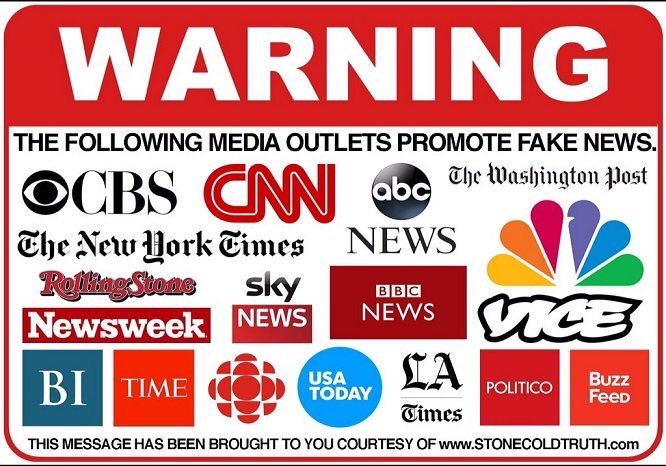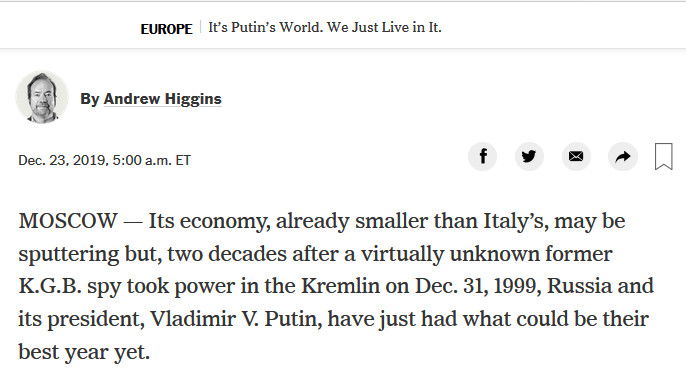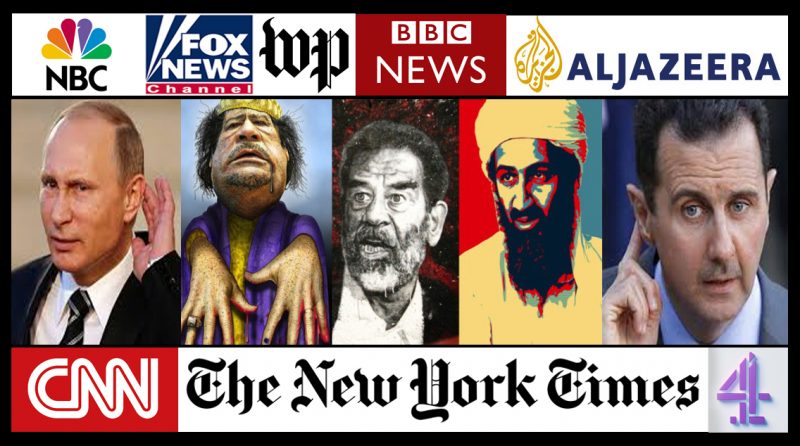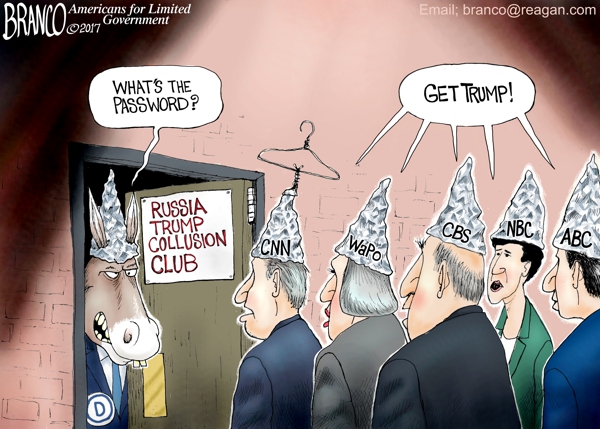
The latest Putin bashing piece in the New York Times is headlined:
It’s Putin’s World. We Just Live in It.
Its economy is sputtering and its young are frustrated, but with America and Europe in tumult, Russia and its leader of two decades are on a roll.
Its first sentence already includes two falsehoods:
Its economy, already smaller than Italy’s, may be sputtering but, two decades after a virtually unknown former K.G.B. spy took power in the Kremlin on Dec. 31, 1999, Russia and its president, Vladimir V. Putin, have just had what could be their best year yet.

The NYT can claim that Russia’s GDP is smaller than Italy’s because it only looked at the nominal Gross Domestic Product (GDP) of those countries. But nominal GDP like nominal wages are not meaningful comparisons. The question is how much can be bought for each nominal unit.
Andrei Martyanov has recently looked at two quite comparable houses, one near Moscow and one near Washington DC. The Russian house costs some $93,000 while the U.S. one is offered for $440,000:
So, let us calculate GDP created by building these two houses in Russia and in US. Right! As you may have guessed it already, the United States created 4.5 times more GDP than Russia by building comparable house in a place which, let’s be frank, is not exactly Moscow. Mind you, that Russia builds all kinds of real estate, from apartments to houses, like there is no tomorrow.
…
Here is how PPP (Purchase Power Parity) GDP works, or, rather confuses most Western think-tank free-loaders who do not understand that most of what they know about the world outside is a baloney or a caricature.
Like the fact that China’s real middle class which has incomes comparable to that of the average US income is larger than the whole population of the United States. That is a good hint.
…
Now, can you scale down, or scale up, Russia’s and American economies? Difficult still but it shows you, at least, what all those proverbial $22 Trillion of the US GDP are worth. Not as much as you may have thought before.

Nor is the argument that Russians do not earn as much entirely valid. Yes, many Russians do not earn as much and that is ongoing problem, but, say, R60,000 which roughly converts into $965, gets you pretty comfortable living practically everywhere in Russia bar some places like Moscow or Sochi, especially if you own you apartment–very many Russians do and by own I mean OWN, not paying mortgage.
There is a lot of what is going into those economic considerations. But it has to be understood today that nominal numbers in USD are absolutely meaningless and, in fact, dangerous because they create a false sense of confidence.
The GDP of Russia, by purchase power parity, is 4,349,423 m$.
The GDP of Italy, by purchase power parity, is 2,442,768 m$.
So it surely does not look as if Russia’s economy is “already smaller than Italy’s”. Corrected by purchase power Russia’s official GDP (PPP) is about as big as Germany’s.
But even that comparison is skewed. Russia’s official GDP is chronically underestimated as the country has a large unofficial economy. It is estimated that 20-30% of all work in Russia is done in exchange for cash and is never officially registered or taxed.
When one considers that Russia currently has no noticeable population growth its economy growth is still fine. It slowed down this year but it is certainly not sputtering:
Economic growth in Russia will be higher than expected in 2019 and is likely to pick up in the next few years thanks partly to higher state spending and looser monetary policy, the World Bank said on Wednesday.
…
The World Bank, in a regular report on the Russian economy, said it expected gross domestic product to expand by 1.2% this year, up from the 1.0% it projected in October. In 2018, Russian GDP grew by 2.3%.
In 2020 Russian GDP is seen at 1.6% and in 2021 1.8%, versus 1.7% and 1.8% respectively projected in October, the World Bank said.
Unlike the Fed and European central banks, which have pushed interest rates to zero to create artificial growth in unproductive financial markets, the Russian central bank held back and still has lots of ammunition left.
And the Russian Federation has a very sound budget and little debt. Should a growth spurt be needed Russia still has, unlike others, the economic ammunition to provide it:
“A less restrictive monetary policy and increased spending on the national projects is expected to help foster growth,” Renaud Seligmann, World Bank Country Director in the Russian Federation, said in the report.

The central bank will next meet on interest rates on Dec. 13, where it may consider cutting the key rate, now at 6.5%, for the fifth time so far in 2019.
The rest of the NYT piece is not any better than its very first paragraph. It simply repeats false stereotypes about Putin as an “autocratic leader” or about the non-existing Russian influence on U.S. elections.
Nearly thirty years ago when the Soviet Union broke apart Russia had a deep fall. The liberalization of its economy had catastrophic consequences. But it has since reformed itself. It is now back to its traditional position in the world.
A large Eurasian power which is in nearly all aspects independent from the rest of the world and able to protect itself. It must therefore be taken into account when one thinks of global polices. That is simply a fact and not the effect of a “mindgame” that Russia allegedly plays with the “west”.
That the U.S. still has problems to understand that is not Russia’s fault but the result of the skewed descriptions of it.

This article was originally published by Moon Of Alabama.
The 21st Century
